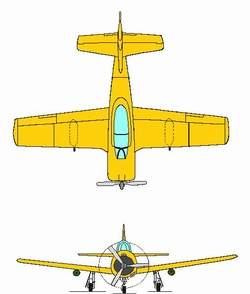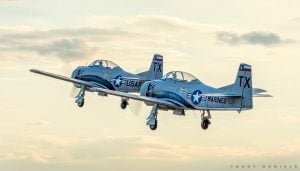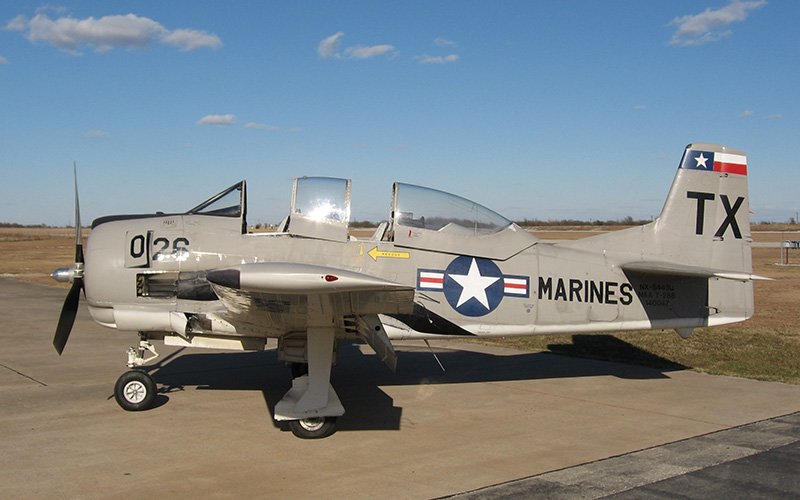 Immediately following World War II, the Department of Defense tapped into the expertise of the North American Aviation Company to develop the next generation, high-performance, advanced primary flight trainer to serve as a successor to the T-6 Texan, also built by North American Aviation. The result was the T-28 series of aircraft.
Immediately following World War II, the Department of Defense tapped into the expertise of the North American Aviation Company to develop the next generation, high-performance, advanced primary flight trainer to serve as a successor to the T-6 Texan, also built by North American Aviation. The result was the T-28 series of aircraft.
The first flight of the T28 prototype was in September of 1949, and the first model of the T28– the T-28A—entered service with the U.S. Air Force in April of 1950. A Wright R-1300, 800 horsepower engine with a two-bladed propeller, powered the T-28A. North American built 1,194 “A” models for the Air Force, who used them from 1950 to 1956, and the Air National Guard continued to use them until 1959.
The U.S. Navy was so impressed with the rugged Trojan that in 1952, the Navy contracted North American Aviation to build an improved version of the Trojan for Navy primary flight training. That improved version of the Trojan turned out to be the T-28B with a more powerful Wright Cyclone R-1820 engine with 1425 horsepower and a three-bladed propeller.
In addition to the “B” model, the T-28C was built for the Navy starting in 1955. The “C” model was equipped with a smaller diameter propeller and a tail hook to allow aircraft carrier landings. The Navy flew a total of 489 “B” models and 299 “C” models for primary flight training and initial carrier qualifications. The service continued to use the aircraft until 1984.
 In 1959, several hundred surplus “A” models were shipped to France where they were modified by Sid Aviation for the French Air Force. The French modifications included a bigger engine, structural improvements, and armament capabilities resulting in what is commonly known as the T-28S (Sud), T28F, or just the Fennec. After success in the counterinsurgency role in Algeria in the early sixties, these 245 Fennec aircraft continued to serve France for many years.
In 1959, several hundred surplus “A” models were shipped to France where they were modified by Sid Aviation for the French Air Force. The French modifications included a bigger engine, structural improvements, and armament capabilities resulting in what is commonly known as the T-28S (Sud), T28F, or just the Fennec. After success in the counterinsurgency role in Algeria in the early sixties, these 245 Fennec aircraft continued to serve France for many years.
In 1962, North American began supplying a different model of the T28 – the T28D—to the U.S. military for combat in Southeast Asia. The T-28D had six underling hardpoints able to accept a variety of weapons from gun pods and rockets to napalm and 500-pound bombs. The 385 “D” model aircraft were used extensively throughout the war zone, including the USAF “Raven” Forward Air Controllers in Laos.
Altogether, North American produced over 2000 T28’s that were used by some 24 different countries around the world. Of those 2000 aircraft built, there are about 400 still flying worldwide.




 Immediately following World War II, the Department of Defense tapped into the expertise of the North American Aviation Company to develop the next generation, high-performance, advanced primary flight trainer to serve as a successor to the T-6 Texan, also built by North American Aviation. The result was the T-28 series of aircraft.
Immediately following World War II, the Department of Defense tapped into the expertise of the North American Aviation Company to develop the next generation, high-performance, advanced primary flight trainer to serve as a successor to the T-6 Texan, also built by North American Aviation. The result was the T-28 series of aircraft. In 1959, several hundred surplus “A” models were shipped to France where they were modified by Sid Aviation for the French Air Force. The French modifications included a bigger engine, structural improvements, and armament capabilities resulting in what is commonly known as the T-28S (Sud), T28F, or just the Fennec. After success in the counterinsurgency role in Algeria in the early sixties, these 245 Fennec aircraft continued to serve France for many years.
In 1959, several hundred surplus “A” models were shipped to France where they were modified by Sid Aviation for the French Air Force. The French modifications included a bigger engine, structural improvements, and armament capabilities resulting in what is commonly known as the T-28S (Sud), T28F, or just the Fennec. After success in the counterinsurgency role in Algeria in the early sixties, these 245 Fennec aircraft continued to serve France for many years.